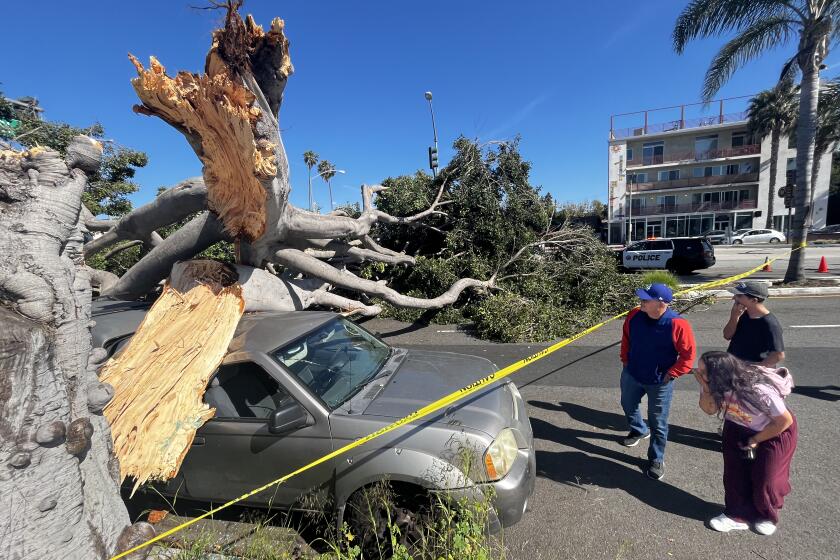Boulevard Merchants at a Crossroads, Report Says
Frustrated by years of talk without action, local business leaders say the merchants on Thousand Oaks Boulevard must take control of reviving the downtown corridor themselves and lobby city officials for help they need.
Abandoning the notion that the whole strip could one day be lined with shops and boutiques like Santa Barbara’s State Street, authors of a new report advocate a simpler approach:
Organize landowners and merchants to seek money for revitalizing storefronts and market the corridor with everything from street fairs to more prominent store signs.
“In essence, the boulevard must learn to identify and market itself more like a mall, at a minimum, a series of distinguishable shopping districts,” states the 20-page report written by members of the Mayor’s Business Roundtable, a group that advises city officials.
The report advocates such ideas as revising sign ordinances and zoning regulations to increase commerce on the boulevard--ideas that have long been divisive in this city.
Already City Councilwoman Linda Parks has questioned its premise, saying its suggestions would result in a gaudy downtown that mirrors commercial development in the San Fernando Valley.
“I like the idea of the boulevard getting together and uniting as a whole,” Parks said. “But I worry about the overall goal.”
For the better part of a decade, civic and business leaders have talked about what can be done to revitalize Thousand Oaks Boulevard, a four-mile retail corridor that stretches through downtown. Some have envisioned a boulevard lined with boutiques and restaurants.
Authors of the new report say their goals aren’t nearly that grand. They say they just want to help downtown businesses become organized so they can compete against such large retail centers in the city as the Promenade at Westlake and the Janss Marketplace.
Advocates say the time is right to revitalize Thousand Oaks Boulevard.
“It’s peaked, disappeared and come back,” Francisco Behr, an architect who helped write the new report, said of the revitalization drive. “I think we’re gaining momentum, because people realize the impact of developments on either side of the boulevard. The stark contrast of the businesses along the boulevard is more visible than it’s ever been.”
Steps proposed in the report and discussed by its supporters include:
* Moving away from talk of making Thousand Oaks Boulevard another downtown Santa Barbara or Old Town Pasadena. Advocates of the current revitalization plan say that parts of the boulevard, perhaps areas near the Civic Arts Plaza, could have boutiques and restaurants for theater patrons, but the boulevard is too sprawling to host a homogenous downtown. “I think parts of the boulevard could be like that, but there’s no way it could stretch the length of the boulevard,” Behr said.
* Revising city ordinances that, according to the report, hurt small businesses, including regulations on commercial signs. The report states: “A well maintained sign, with bright colors and lighting that is functional, says to potential customers, ‘We are here, we care and we want your business.’ Likewise, a dull and worn sign says, ‘We are tired and may not be around much longer--your business isn’t that important to us.’ ”
* Considering increasing residential development on the boulevard. The report states new “entry-level single and start-up housing” along the street would bring new customers to businesses there.
* Creating organizations that could channel public money to businesses on the boulevard. Advocates of the latest revitalization drive say the first step they must take is to organize businessmen and landowners on the boulevard, so they can position themselves to receive public funding.
The report suggests business owners and property owners work together in business improvement districts, described as collective management associations that focus on group advertising and events such as holiday promotions and street-side festivals.
At a recent Mayor’s Business Roundtable meeting, Mario Diaz , a local insurance agent, handed out a timetable stating that merchants and landowners should begin organizing in the next few months and that they should urge the City Council to approve the creation of an economic development corporation by June.
Chamber of Commerce Executive Director Fred Burkhardt is scheduled to give a presentation on the proposed corporation to the Mayor’s Business Roundtable later this month.
Diaz said an economic development corporation, which would receive seed money from the city and seek grants for local merchants, could help businesses along the boulevard spruce up their storefronts and attract more customers.
“What this report really is, is to recognize that there’s a need--the boulevard needs to grow,” Diaz said. “By that I mean, some people on the boulevard are feeling left behind. . . . The key here is we’re trying to get owners of properties and businesses working together. They should be thinking along these lines, because it’s in their best interest.”
Councilwoman Parks said that before the city establishes an economic development corporation, she wants to be sure the organization would focus on helping small merchants on the boulevard, rather than luring new businesses to it.
“The question is, does it channel redevelopment money to existing businesses?” Parks said. “I’m all for the existing businesses, but I would be leery of a program that brings in what I see as urban influences.”
Parks said she is especially wary of new housing developments. She said more residents would increase traffic congestion on the boulevard. “It goes against the semirural, the character of our town,” she said.
Parks said many of the proponents of the plan do not have businesses on Thousand Oaks Boulevard, and their interests might not be the same as the small business owners there.
For example, Parks said, the new report states that one problem is that lease rates on Thousand Oaks Boulevard are low relative to commercial areas in Westlake Village and Agoura Hills.
“High lease rates should not be the goal,” Parks said. “I don’t think businesses on the boulevard are saying, ‘What a shame, our lease rates are low.’ ”
Bob Warner, who sells carpets in an aging shopping center near the Civic Arts Plaza, said he was not aware of the planned organizing drive. But Warner said he would like to get help in fixing the leaky storefront he leases.
Heavy rains earlier this winter dripped through his roof, destroying carpet samples and damaging desks and computers, he said. Working near the Civic Arts Plaza makes him feel like a “strange neighbor,” he said.
“What you have is this multimillion, state-of the art complex, and this center I’m in across the street that was built in the 1960s,” said the 45-year-old Warner, who has lived in Thousand Oaks since he was 7.
Behr said the $86-million Civic Arts Plaza is one of the new developments creating a sense of urgency about reviving Thousand Oaks Boulevard.
“The city made a big investment,” Behr said. “For that to yield any fruit in the future, the focus needs to be on the boulevard.”
More to Read
Start your day right
Sign up for Essential California for news, features and recommendations from the L.A. Times and beyond in your inbox six days a week.
You may occasionally receive promotional content from the Los Angeles Times.





